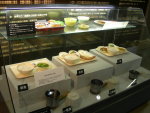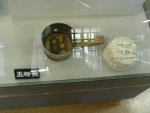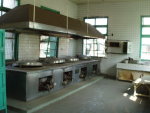Food
Relationship between prison food and social standards

(The kitchen)
(picture source:photo by this team)
Food in the prison has to consider whether it is sufficient, and the size of portions. However, prison food would also change with standards in the rest of society. If the people have nothing to eat, then the prisoners cannot still have meat and fish. For example, between the period of Japanese rule and Retrocession, the standards of living were not very high in Taiwan, thus the food quality was not very good in prison. Under Japanese rule, the prison moved most of Taiwanese produce back to Japan, so that there was a large disparity between the quality and quality of prison food. Current prison food has a night-and-day difference from prison food in the past. Now, every inmate must pay NT$1,500 per month for food (increased to NT$1,800 in January of 2009).
Food under Japanese rule

(The meal in the prison)
(picture source:Provide by New Chaiyi prison.)
At the time, prison food was ranked based on behavior, so sometimes inmates starved to death. Under Japanese rule, food was ranked according to behavior from first level to fifth level, with a different quantity of rice. Prisoners of the first rank received the largest rice balls, and the lower levels had smaller rice balls.
Introduction of current food

(The best meal in the prison)
(picture source:Provide by New Chaiyi prison.)
The food of current inmates is determined by the food team, who creates the menu, then offer bids to vendors and choose the better food. Or, sometimes some vegetables from the garden at the prison are cooked. Sometimes there are three dishes plus one soup, other times there are two dishes plus one soup. Prices differ based on the dishes. For special holidays, there are additional dishes (the source of funds for these added dishes is 10% of prisoner labor wages, and 0.15% of donations and co-op income).
The cooking is usually done by some short-term inmates. For breakfast and on holidays, the inmates eat in the cells, and regular lunches and suppers take place at the factories. On the cells, the wall near the hallway would have an opening to place food, placed in a small case delivered through the opening, and the leftovers are sent back out through the opening.
"Why are the short-term inmates sent to cook? This is not absolute. The prison administrators would consider some elements such as daily behavior, whether they are good at cooking, or individual willingness of the inmates."
"The reason that the opening for food is placed up on the walls is to prevent being tipped over by the inmates, so it is on the floor, and to avoid the possible attacks if inmates pull the delivery person's hand. This is why the food delivery opening is designed below the doors."
Other avenues for nutrients
Sometimes inmates use other methods to satisfy their nutritional needs, such as dishes from visitation and the co-op.
-
Dishes from visitation
These refer to foods brought by family members. These dishes must go through examination procedures (involving cutting, slicing, kneading, rubbing, looking, and smelling) before it can be given to inmates. For example, fruit cannot be given to prisoners because it can be made into wine.
-
Co-op
When inmates come in, they have their own accounts. Inmates can use the money in their own accounts to make purchases from the co-op store, which has everything. The things needed by inmates would be sent by the co-op to the inmates when they have meals.
-
Co-op orders

(Inside the kitchen)
(picture source:photo by this team)
In the past, those in the prison can order food from the co-op, these are referred to as co-op orders. However, these are no longer provided by the prison co-op, because there were powerful inmates that asked other prisoners to make frequent co-op orders. This tended to cause management problems for the prison administration. Also, now the prison food is quite good both in terms of quality and types of dishes, so no one makes co-op orders anymore.
Prison food has always been changing since the Japanese period, and food culture has developed in prison. From their food, we can learn things about the development of prison history. It is hoped that people would understand every corner of the prison, so that life behind the tall walls were no longer a mystery. This is history left by people who worked hard and lived; things may change and disappear with time, but history can be preserved in the hearts of everyone.
Sources:
-
Researched and organized by this team
-
Interviews with Ms. Chiu Mr. Lee
-
Nanhua University Master's thesis: Construction of Three Dimensions in Arenas of Power Study of Chiayi City, Old Chiayi Prison, and the Body
